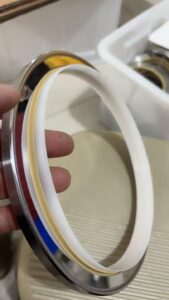Table of Contents
ToggleWhat Is the Best Oil Seal for High Temperatures?
Selecting the optimal oil seal for high-temperature applications demands materials that retain elasticity, resist thermal degradation, and maintain sealing integrity under extreme conditions. Below is a detailed guide to the top materials, their capabilities, and practical recommendations to address the challenges of heat-intensive environments.


1. Top Materials for High-Temperature Oil Seals
A. Viton® (Fluorocarbon Rubber, FKM)
- Temperature Range:
- -20°C to +200°C (short-term up to 250°C with specialty grades).
- Advantages:
- Heat and Chemical Resistance: Excels against oils, fuels, acids, and solvents.
- Low Compression Set: Maintains sealing force even after prolonged heat exposure.
- Applications:
- Turbochargers, exhaust systems, industrial pumps, and chemical processing equipment.
- Limitations:
- Stiffens below -15°C (use GLT grades for sub-zero performance).
B. PTFE (Polytetrafluoroethylene)
- Temperature Range:
- -200°C to +260°C (short-term up to 300°C).
- Advantages:
- Unmatched Thermal Stability: Resists nearly all chemicals and offers low friction.
- Zero Swelling: Ideal for dynamic seals in high-speed machinery.
- Applications:
- Aerospace hydraulics, semiconductor manufacturing, steam valves.
- Limitations:
- High cost and requires precise installation.
C. Silicone (VMQ)
- Temperature Range:
- -60°C to +230°C (short-term up to 250°C).
- Advantages:
- Flexibility in Cold: Performs well in thermal cycling (e.g., cold starts).
- Oxidation Resistance: Suitable for outdoor or weathering conditions.
- Applications:
- Automotive cooling systems, oven door seals.
- Limitations:
- Poor compatibility with petroleum oils and fuels.
D. Aflas® (TFE/P)
- Temperature Range:
- -20°C to +230°C (short-term up to 250°C).
- Advantages:
- Chemical Resistance: Handles amines, caustics, and acidic media.
- Applications:
- Oil and gas drilling, chemical reactors.
- Limitations:
- Limited availability and higher cost.
2. Critical Comparison of High-Temperature Materials
| Factor | Viton (FKM) | PTFE | Silicone (VMQ) | Aflas® (TFE/P) |
| Max Temperature | 200°C | 260°C | 230°C | 230°C |
| Oil/Fuel Resistance | Excellent | Exceptional | Poor | Excellent |
| Chemical Resistance | Acids, solvents | All chemicals | Weak | Amines, caustics |
| Cost | Moderate-High | Very High | Moderate | High |
3. Application-Specific Recommendations
- Automotive/Engines:
- Viton (FKM): Turbochargers, exhaust seals (heat resistance up to 200°C).
- Aerospace/Industrial:
- PTFE: Extreme heat (260°C+) and chemical exposure (e.g., jet engines).
- Chemical Processing:
- Aflas®: Amine-rich environments or caustic fluid handling.
- Thermal Cycling:
- Silicone (VMQ): Applications requiring flexibility from -60°C to 230°C.
4. Design Considerations for High-Temperature Seals
- Backup Rings: Use PTFE or metal rings in high-pressure systems (>35 MPa) to prevent extrusion.
- Surface Finish: Polished mating surfaces reduce friction and heat buildup.
- Lubrication: High-temperature silicone grease enhances seal lifespan.
5. Common Failure Modes
- Thermal Degradation: Cracking or hardening due to prolonged heat exposure.
- Chemical Swelling: Material breakdown in aggressive media (e.g., biofuels).
- Compression Set: Loss of elasticity under continuous pressure and heat.
6. Final Recommendations
- Best Overall: Viton (FKM) for balanced heat resistance, oil compatibility, and cost-effectiveness.
- Extreme Heat (>200°C): PTFE for unmatched thermal and chemical stability.
- Specialized Needs: Aflas® for caustic resistance; Silicone for thermal flexibility.
Key Takeaways
- Viton (FKM) and PTFE are the top choices for most high-temperature oil seals.
- Material selection must prioritize temperature extremes, chemical exposure, and mechanical stress.
- Always validate compatibility using manufacturer charts (e.g., Parker Hannifin, DuPont™).
By aligning material properties with operational demands, engineers can ensure reliable sealing performance, minimize downtime, and extend equipment longevity in even the most heat-intensive environments.



Leave A Comment